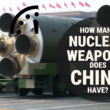No sentimental undertaking
By Héctor Guerra, July 18, 2014
Nuclear weapons are a genie that can’t be returned to the bottle—this is a familiar sentiment, repeated for decades. But the humanitarian initiative toward disarmament is another genie that is out of its bottle. My roundtable colleague Bharat Karnad referred in Round One to a treaty banning nuclear weapons, such as might result from the humanitarian initiative, as "a hollow exercise performed by lesser states" and "a prick to the conscience—little more." From this one might get the impression that the humanitarian initiative is just a sentimental undertaking, a hopeless appeal by the meek to the czars of the nuclear weapons establishment. But in fact the humanitarian initiative is a highly realistic construction.
To begin with, it is a broad-based movement built on the accumulated experience of many: diplomats young and old, scientists and academics, activists and practitioners from civil society and nongovernmental organizations, survivors of armed violence, environmentalists, parliamentarians and jurists, artists, and others. These individuals come from countries with nuclear weapons on their territory; from nations that do not have nuclear weapons, but rely on other governments’ weapons of mass destruction for their "security"; and from regions of the world where nations make do without nuclear weapons entirely.
More than this, the humanitarian initiative is based on a mature understanding of disarmament history. It is not some whim—blind to the measures taken since 1946 both to prevent proliferation and to promote disarmament. It is not blind to earlier debates about the legality of using or threatening to use nuclear weapons, and whether their use would constitute a war crime. Indeed, the initiative is founded on a keen awareness that, because the world still faces the threat of nuclear weapons after nearly 70 years of disarmament efforts, additional measures are needed.
New strategies. Karnad writes that the international system is "based on power politics" and that, within it, "economic heft and military might indeed make right." He notes that six nuclear-armed nations account for about 45 percent of global economic activity. But the "realism" that Karnad espouses accepts too easily the risks that accompany power politics—war, injustices including human rights violations, and crimes against humanity. "Realism" accepts too readily today’s concentration of economic power, whereby 1 percent of the world’s population holds almost half of global wealth.
But more importantly, power doesn’t depend only on military and economic might. Over time, human beings have demonstrated the capacity to develop new strategies for collective survival—strategies encompassing cooperation, self-restraint, empathy, compassion, and solidarity. At the global level, these strategies have taken the form of international norms, institutions, and legal structures that, most of the time, allow peaceful relations among nations and enable human beings to resolve their differences without resorting to war. This is the breeding ground of the humanitarian initiative. This is what gives the initiative a real chance of success. This is the counterargument to a deterministic worldview that doesn’t extend beyond the tip of a missile.
A few individuals within a nuclear establishment can determine the fate of a country’s entire populace. A few states can set the conditions of life or death for billions. What does this mean for the development of democracy around the world? What does this say about human civilization’s prospects? Fortunately, it’s possible to escape the bounds of the weapons-based "realist" determinism that seeks to constrain people’s minds. The humanitarian initiative is one means of constructing a different reality.
Topics: Nuclear Weapons
Share: [addthis tool="addthis_inline_share_toolbox"]














